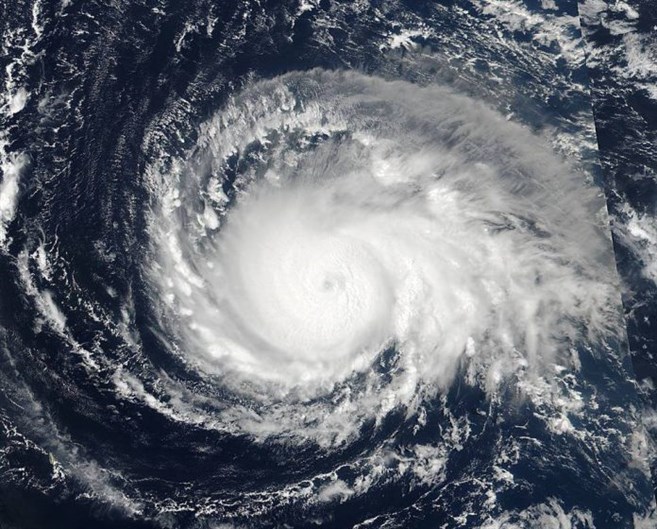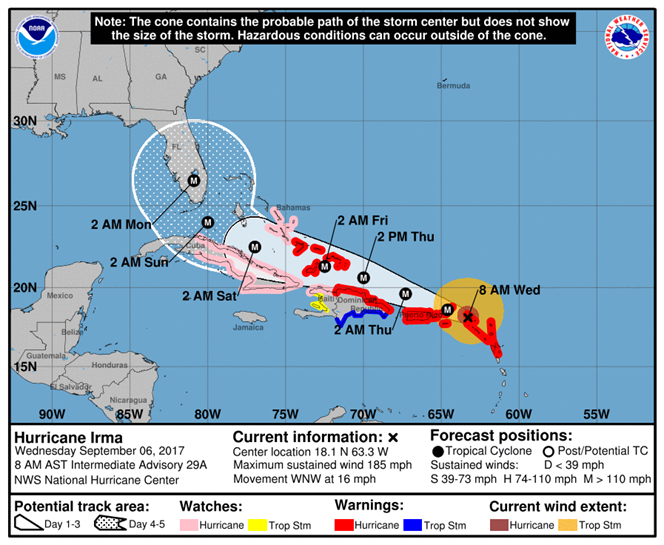EYE OF CATEGORY 5 HURRICANE IRMA PASSES OVER ST MARTIN
Fuente: http://wp.caribbeannewsnow.com/

MIAMI, USA.- Hurricane Irma, a Category 5 hurricane, pounded the Caribbean islands of St Martin and Anguilla, where sustained winds of 117 mph were measured on Wednesday morning, as the potentially catastrophic storm headed towards the Virgin Islands, Puerto Rico, Hispaniola, The Bahamas and Cuba.
Irma’s maximum sustained winds were steady at 185 mph based on data from NOAA and Air Force Hurricane Hunter aircraft. Based on wind speed, Irma is the strongest Atlantic hurricane since Wilma in 2005, which also had maximum sustained winds of 185 mph.
Additionally, Irma is just the fifth Atlantic hurricane to have maximum sustained winds of 185 mph or greater, according to Dr Phil Klotzbach, a tropical scientist at Colorado State University. Hurricane Allen occupies the top spot with 190 mph winds in 1980.
According to the National Hurricane Center (NHC) in Miami, at 8:00 am EDT on Wednesday, the eye of Hurricane Irma was located about 15 miles (25 km) west of St Martin and about 15 miles (25 km) west-southwest of Anguilla, moving toward the west-northwest near 16 mph (26 km/h). This general motion is expected to continue for the next couple of days.
 Credits: http://wp.caribbeannewsnow.com/
Credits: http://wp.caribbeannewsnow.com/
On the forecast track, the extremely dangerous core of Irma will move over portions of the northern Virgin Islands on Wednesday, pass near or just north of Puerto Rico Wednesday afternoon or night, and pass near or just north of the coast of the Dominican Republic on Thursday.
Maximum sustained winds remain near 185 mph (295 km/h) with higher gusts. Irma is a category 5 hurricane on the Saffir-Simpson Hurricane Wind Scale. Some fluctuations in intensity are likely during the next day or two, but Irma is forecast to remain a powerful category 4 or 5 hurricane during the next couple of days.
Hurricane-force winds extend outward up to 50 miles (85 km) from the center and tropical-storm-force winds extend outward up to 175 miles (280 km). A wind gust to 90 mph (146 km/h) was reported on the island of St Eustatius located south of the eye of Irma. A NOAA National Ocean Service station on Barbuda reported sustained winds of 118 mph (190 km/h) with a gust to 155 mph (249 km/h) before the instrument failed earlier Wednesday morning.
A hurricane warning is in effect for Antigua and Barbuda, Anguilla, Montserrat, St Kitts and Nevis, Saba, St Eustatius, St Maarten, St Martin, St Barthelemy, British Virgin Islands, US Virgin Islands, Puerto Rico, Vieques, Culebra, Dominican Republic from Cabo Engano to the northern border with Haiti, Guadeloupe, southeastern Bahamas and the Turks and Caicos Islands.
A hurricane watch is in effect for Haiti from the northern border with the Dominican Republic to Le Mole St Nicholas, Turks and Caicos Islands, southeastern Bahamas, Cuba from Matanzas province eastward to Guantanamo province, and the central Bahamas.
A tropical storm warning is in effect for Dominican Republic from south of Cabo Engano westward to the southern border with Haiti.
A tropical storm watch is in effect for Haiti from south of Le Mole St Nicholas to Port-Au-Prince.
Interests elsewhere in the Dominican Republic and Haiti, as well as Cuba, and the northwestern Bahamas, should monitor the progress of Irma.
The combination of a life-threatening storm surge and large breaking waves will raise water levels above normal tide levels by the following amounts within the hurricane warning area near and to the north of the centre of Irma. Near the coast, the surge will be accompanied by large and destructive waves. Northern Leeward Islands 7 to 11 ft; Turks and Caicos Islands 15 to 20 ft; southeastern Bahamas 15 to 20 ft; northern coast of the Dominican Republic 3 to 5 ft; northern coast of Haiti and the Gulf of Gonave 1 to 3 ft.
The combination of a life-threatening storm surge and the tide will cause normally dry areas near the coast to be flooded by rising waters moving inland from the shoreline. The water is expected to reach the following heights above ground if the peak surge occurs at the time of high tide: British and US Virgin Islands except St Croix 7 to 11 ft; northern coast of Puerto Rico 3 to 5 ft; southern coast of Puerto Rico and St Croix 1 to 2 ft.
The deepest water will occur along the immediate coast in areas of onshore winds, where the surge will be accompanied by large and destructive waves. Surge-related flooding depends on the relative timing of the surge and the tidal cycle, and can vary greatly over short distances.
Hurricane conditions will continue Wednesday within the hurricane warning area in the Leeward Islands. Hurricane conditions are expected to begin within the British and US Virgin Islands on Wednesday morning and spread westward over portions of Puerto Rico later in the day. Hurricane conditions are expected to begin within the hurricane warning area in the Dominican Republic early Thursday, with tropical storm conditions beginning Wednesday night. Hurricane conditions are expected in the warning area in the southeastern Bahamas and the Turks and Caicos Islands beginning Thursday night. Hurricane and tropical storm conditions are possible within the watch area in Haiti by early Thursday and in the central Bahamas and Cuba by Friday.
Irma is expected to produce the following rain accumulations through Thursday: northern Leeward Islands 8 to 12 inches, isolated 20 inches; northeast Puerto Rico and the British and US Virgin Islands 4 to 10 inches, isolated 15 inches; southwest Puerto Rico, the southern Leeward Islands, and St Croix 2 to 4 inches.
Irma is expected to produce the following rain accumulations Wednesday through Saturday: southeast Bahamas, the Turks and Caicos and eastern to central Cuba 8 to 12 inches, isolated 20 inches; northern Dominican Republic and northern Haiti 4 to 10 inches, isolated 15 inches; southwest Haiti 1 to 4 inches. In all areas this rainfall may cause life-threatening flash floods and mudslides.
Swells generated by Irma will affect the northern Leeward Islands, Puerto Rico, the Virgin Islands, the southeastern Bahamas, the Turks and Caicos Islands, and the northern coast of the Dominican Republic during the next several days. These swells are likely to cause life-threatening surf and rip current conditions.








